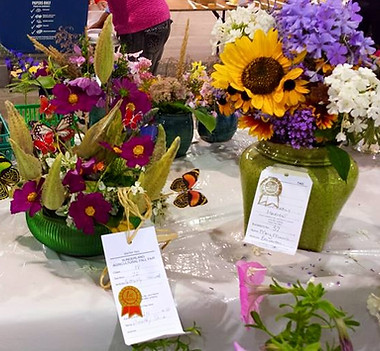
Flower Shows
Flower shows are open for all current members to exhibit their specimens and designs. Held each month at our regular meetings and judged with points awarded.
Complete listing for shows may be found in club yearbook with categories in specimen, decorative and photography divisions. Exhibits must be in place by the time stated on the flower show program.
Please refer to our yearbook for complete details. Exhibiting and design tips listed below.
Learn.Grow.Enjoy with CHS.



The Ontario Judging and Exhibiting Standards for Horticulture and Floral Design is the recommended reference guide for exhibiting in Ontario. Copies may be obtained from the Flower Show Committee for $6.00 each. Another excellent guide is The Encyclopedia of Judging and Exhibiting, Floriculture and Flora-Artistry by Esther Veramae Hamel and available in Society’s library.
-
Always follow the show schedule and rules, and name specimens whenever possible.
-
Ensure the correct number (and colour) of specimens (or blooms) is exhibited. A bud showing colour is counted as a bloom, so consider this when the class specifies a particular number.
-
Conditioning and hardening aid plants to absorb water after cutting, and preserve longer lasting freshness of specimens.
-
Conditioning:
-
Cut stems cleanly on a slant using a sharp, clean knife or shears; best times are early morning or late evening; cut more blooms than required.
-
Remove leaves from lower half of stems; upper foliage must be attached unless otherwise stated. Place immediately in warm water.
-
Some plants do not absorb water as freely as others, and require further treatment prior to hardening:
-
chrysanthemums
-
lilies
-
narcissus
-
peonies
-
poppies
-
tulips, etc.
-
-
-
Hardening:
-
Place cut flowers and foliage in deep warm water immediately after conditioning in a cool, dark, humid, draft-free area for 4 to 6 hours (or overnight).
-
See pages 43A-43D of The Encyclopedia of Judging and Exhibiting for information on specific plants
Exhibiting Tips
Design Tips
Design Division - Principles of Design:
The principles of design are basic standards used to organize, define & evaluate the design, its elements & components. They are as follows.
-
Balance: is the visual stability from any angle or any dimension. A balanced design does not appear top-heavy, bottom-heavy or lopsided.
-
Rhythm: is the visual path that suggests motion in the design accomplished by the repetition of an element at regular or irregular intervals. This can be expressed in line, form, colour, spacing between flowers or the simple repeating of curves or planes within a composition.
-
Proportion: is the relative amount of one area to another, i.e.: the amount of plant material to the container, the amount of round forms to linear forms, the amount of rough texture to smooth.
-
Scale: is the size relationship of all components. i.e.: the size of one flower in relation to another, etc.
-
Contrast: is difference. Achieved by placing opposite or unlike elements together in such a way as to emphasize difference.
-
Dominance: is the force of one element implying subordination.
Scale of Points for Design:
Design ...................................................35
Conformance ...................................25
Creativity .............................................20
Distinction & Condition .............20
Horticultural Division - Terminology:
-
Balance: is the arrangement of the leaves & florets on the stem. The balance should be even and pleasing.
-
Colour: should be typical of the cultivar. Variegation should be true for the cultivar.
-
Condition: is the actual physical appearance of the entry at the time of judging. Specimens that are over-mature are not of good exhibition quality.
-
Distinction: is marked superiority in all respects – it is better, closer to perfection than any other specimen.
-
Floriferousness: is abundance of flowers.
-
Form: is the overall shape of the plant, flower, leaf and/or stem and should be characteristic of the cultivar.
-
Grooming: is the removal of any evidence of spray, dust, insect damage, foreign materials, or of any faded or wilted petals or leaves.
-
Labeling: should be neat and legible with the correct botanical/common name and cultivar.
-
Size: should be normal for a well-grown specimen of the cultivar exhibited.
-
Stem & Foliage: Stem & flower(s) should be in good proportion. The stem should be sufficiently strong to support the bloom(s). Only attached foliage is permitted unless otherwise stated.
-
Substance: quality of firmness of flower or leaf enabling it to retain its characteristic form, freshness & colour.
-
Texture: is the surface quality of plant materials, the smoothness or roughness.
-
Uniformity: When two or more specimens of a given cultivar are shown as one entry, they should be as uniform as possible in size.
Scale of Points for Specimens:
Flowering/Fruited/Hanging Flowering/Potted Bulbs
Flowering/Fruited plants are grown primarily for the attractiveness & abundance of bloom/fruit. Floriferousness refers to the abundance of bloom/fruit, which should be of high quality.
Cultural Perfection .......................................................50
Form & Symmetry .........................................................20
Size of Plant (according to cultivar) .................10
Foliage (healthy & unblemished) ......................10
Grooming .............................................................................10
Flowers or Fruit ...............................................................35
Quality (peak of perfection) ...................................10
Floriferousness (quantity of bloom/fruit) ....15
Colour .......................................................................................5
Size ..............................................................................................5
Distinction ............................................................................10
Named .................................................................................... 5
Scale of Points for Specimens:
Foliage Plants/Hanging Foliage Plants/Cacti
Foliage plants are grown primarily for the attractiveness & the interest of the leaves. Cacti are grown primarily for the interest of the plant (shape, colour, texture. etc.)
Cultural Perfection ..........................................45
Form & Symmetry ............................................25
Size of Plant (according to cultivar) ....10
Grooming ................................................................10
Foliage ......................................................................40
Quality (healthy & unblemished) ..........30
Colour ........................................................................10
Distinction ..............................................................10
Named ........................................................................5






